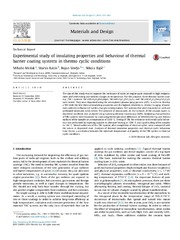Experimental study of insulating properties and behaviour of thermal barrier coating systems in thermo cyclic conditions
Апстракт
The aim of this study was to improve the resistance of turbo jet engine parts exposed to high temperatures and overheating and sudden changes in temperature. For this purpose, three thermal barrier coating (TBC) systems NiCrAlCoY2O3/ZrO2MgO, NiCrAlCoY2O3/ZrO2Y2O3 and NiCrAlCoY2O3/ZrO2CeO2Y2O3 were tested. They were deposited using the atmospheric plasma spray process (APS). In order to develop a TBC with the best thermal insulating properties and the highest reliability in relation to aging of materials under the influence of sudden changes in temperature, TBC systems that were deposited on cold and preheated substrates were tested. The network of microcracks on the surfaces of the ceramic layers in deposited condition was analyzed using scanning electron microscopy (SEM). Insulating characteristics of TBC systems were examined by measuring the temperature difference Delta T between the top and bottom surfaces of the samples at a temperature of 1200 degrees C. Testing of TBC for resist...ance to thermal cyclic behaviour was performed by exposing samples to alternate heating at 1200 degrees C and rapid cooling of the samples to 180 degrees C. Microhardnesses of the TBC system, after completion of thermal cycles, were compared with the values in deposited state. Analyses of thermal insulation properties and thermal cyclic behaviour have shown a correlation between the substrate temperature and quality of the TBC system in thermal cyclic conditions.
Извор:
Materials & Design, 2015, 67, 337-343Издавач:
- Elsevier Sci Ltd, Oxford
Финансирање / пројекти:
- Микромеханички критеријуми оштећења и лома (RS-MESTD-Basic Research (BR or ON)-174004)
- Развој технологије израде облоге и језгра на бази домаћих сировина за производњу специјалних обложених електрода намењених за електролучно заваривање челика (RS-MESTD-Technological Development (TD or TR)-34016)
DOI: 10.1016/j.matdes.2014.11.029
ISSN: 0264-1275
WoS: 000346852100038
Scopus: 2-s2.0-84921486522
Колекције
Институција/група
Tehnološko-metalurški fakultetTY - JOUR AU - Mrdak, Mihailo AU - Rakin, Marko AU - Međo, Bojan AU - Bajić, Nikola PY - 2015 UR - http://TechnoRep.tmf.bg.ac.rs/handle/123456789/3016 AB - The aim of this study was to improve the resistance of turbo jet engine parts exposed to high temperatures and overheating and sudden changes in temperature. For this purpose, three thermal barrier coating (TBC) systems NiCrAlCoY2O3/ZrO2MgO, NiCrAlCoY2O3/ZrO2Y2O3 and NiCrAlCoY2O3/ZrO2CeO2Y2O3 were tested. They were deposited using the atmospheric plasma spray process (APS). In order to develop a TBC with the best thermal insulating properties and the highest reliability in relation to aging of materials under the influence of sudden changes in temperature, TBC systems that were deposited on cold and preheated substrates were tested. The network of microcracks on the surfaces of the ceramic layers in deposited condition was analyzed using scanning electron microscopy (SEM). Insulating characteristics of TBC systems were examined by measuring the temperature difference Delta T between the top and bottom surfaces of the samples at a temperature of 1200 degrees C. Testing of TBC for resistance to thermal cyclic behaviour was performed by exposing samples to alternate heating at 1200 degrees C and rapid cooling of the samples to 180 degrees C. Microhardnesses of the TBC system, after completion of thermal cycles, were compared with the values in deposited state. Analyses of thermal insulation properties and thermal cyclic behaviour have shown a correlation between the substrate temperature and quality of the TBC system in thermal cyclic conditions. PB - Elsevier Sci Ltd, Oxford T2 - Materials & Design T1 - Experimental study of insulating properties and behaviour of thermal barrier coating systems in thermo cyclic conditions EP - 343 SP - 337 VL - 67 DO - 10.1016/j.matdes.2014.11.029 ER -
@article{
author = "Mrdak, Mihailo and Rakin, Marko and Međo, Bojan and Bajić, Nikola",
year = "2015",
abstract = "The aim of this study was to improve the resistance of turbo jet engine parts exposed to high temperatures and overheating and sudden changes in temperature. For this purpose, three thermal barrier coating (TBC) systems NiCrAlCoY2O3/ZrO2MgO, NiCrAlCoY2O3/ZrO2Y2O3 and NiCrAlCoY2O3/ZrO2CeO2Y2O3 were tested. They were deposited using the atmospheric plasma spray process (APS). In order to develop a TBC with the best thermal insulating properties and the highest reliability in relation to aging of materials under the influence of sudden changes in temperature, TBC systems that were deposited on cold and preheated substrates were tested. The network of microcracks on the surfaces of the ceramic layers in deposited condition was analyzed using scanning electron microscopy (SEM). Insulating characteristics of TBC systems were examined by measuring the temperature difference Delta T between the top and bottom surfaces of the samples at a temperature of 1200 degrees C. Testing of TBC for resistance to thermal cyclic behaviour was performed by exposing samples to alternate heating at 1200 degrees C and rapid cooling of the samples to 180 degrees C. Microhardnesses of the TBC system, after completion of thermal cycles, were compared with the values in deposited state. Analyses of thermal insulation properties and thermal cyclic behaviour have shown a correlation between the substrate temperature and quality of the TBC system in thermal cyclic conditions.",
publisher = "Elsevier Sci Ltd, Oxford",
journal = "Materials & Design",
title = "Experimental study of insulating properties and behaviour of thermal barrier coating systems in thermo cyclic conditions",
pages = "343-337",
volume = "67",
doi = "10.1016/j.matdes.2014.11.029"
}
Mrdak, M., Rakin, M., Međo, B.,& Bajić, N.. (2015). Experimental study of insulating properties and behaviour of thermal barrier coating systems in thermo cyclic conditions. in Materials & Design Elsevier Sci Ltd, Oxford., 67, 337-343. https://doi.org/10.1016/j.matdes.2014.11.029
Mrdak M, Rakin M, Međo B, Bajić N. Experimental study of insulating properties and behaviour of thermal barrier coating systems in thermo cyclic conditions. in Materials & Design. 2015;67:337-343. doi:10.1016/j.matdes.2014.11.029 .
Mrdak, Mihailo, Rakin, Marko, Međo, Bojan, Bajić, Nikola, "Experimental study of insulating properties and behaviour of thermal barrier coating systems in thermo cyclic conditions" in Materials & Design, 67 (2015):337-343, https://doi.org/10.1016/j.matdes.2014.11.029 . .



